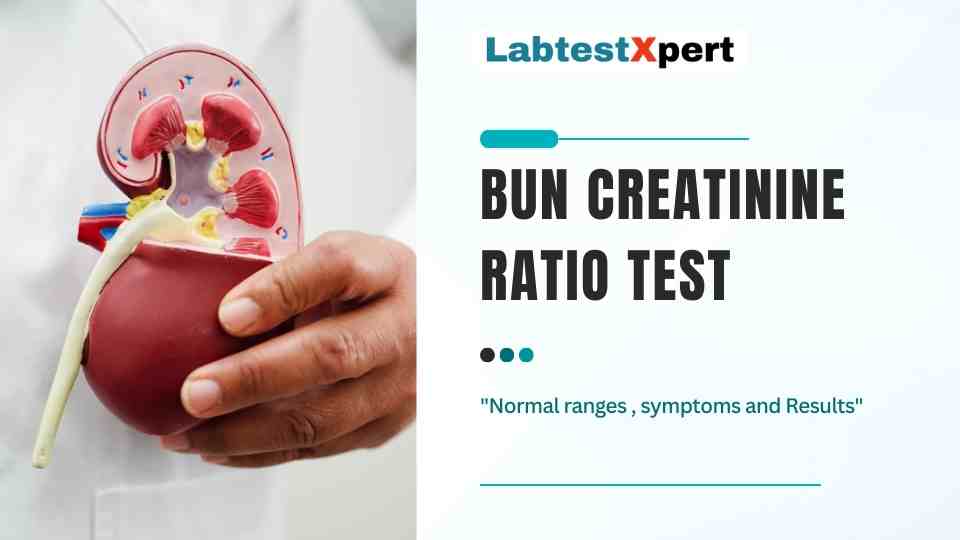Introduction to Bun Creatinine Ratio
The Bun Creatinine Ratio serves as a vital indicator in medical diagnostics, offering valuable insights into kidney function and overall health status. Here’s an overview of what it entails and its significance in health assessment:
What is BUN Creatinine Ratio?
The Bun Creatinine Ratio is a measure that compares the levels of two important substances in the blood: Blood Urea Nitrogen (BUN) and Creatinine. BUN is a waste product produced when the liver breaks down proteins, while Creatinine is a byproduct of muscle metabolism. Both substances are filtered by the kidneys and expelled through urine. The ratio between BUN and Creatinine provides healthcare professionals with crucial information about kidney function and hydration levels within the body.
Importance of BUN Creatinine Ratio in Health Assessment
The Bun Creatinine Ratio holds significant importance in health assessment for several reasons. Firstly, it serves as a valuable marker for evaluating kidney function. Changes in the ratio may indicate issues such as kidney disease or impaired renal function. Additionally, the ratio helps in monitoring hydration levels within the body. Dehydration can lead to an increase in BUN levels relative to Creatinine, highlighting the importance of maintaining proper hydration for overall health. Moreover, abnormal Bun Creatinine Ratio levels can also indicate underlying medical conditions such as liver disease or heart failure, making it a versatile tool in diagnosing various health issues.
Understanding the Bun Creatinine Ratio and its importance in health assessment is essential for healthcare professionals to accurately diagnose and manage various medical conditions effectively.
Understanding BUN and Creatinine
Blood Urea Nitrogen (BUN) and Creatinine are two essential substances found in the blood that play significant roles in assessing kidney function and overall health. Here’s a breakdown of each:
Explanation of BUN (Blood Urea Nitrogen):
Blood Urea Nitrogen, commonly referred to as BUN, is a waste product generated by the liver during the breakdown of proteins. After production, BUN circulates in the bloodstream and eventually reaches the kidneys. The kidneys filter BUN from the blood and excrete it from the body through urine. Elevated levels of BUN may indicate issues with kidney function, dehydration, or other medical conditions affecting protein metabolism. Conversely, decreased BUN levels could suggest liver disease or malnutrition.
Explanation of Creatinine:
Creatinine is a waste product produced by muscles as they metabolize creatine, a substance found naturally in muscle tissue. Like BUN, creatinine is filtered by the kidneys and excreted through urine. The production of creatinine is relatively constant, making it a reliable indicator of kidney function. Elevated creatinine levels in the blood may signal impaired kidney function or reduced kidney filtration rate. Conversely, low creatinine levels may indicate decreased muscle mass or certain medical conditions affecting muscle metabolism.
Relationship between BUN and Creatinine:
The relationship between BUN and creatinine is often used to assess kidney function. Typically, the BUN creatinine ratio falls within a specific range in healthy individuals. However, alterations in this ratio can indicate underlying health issues. For instance, an increased BUN creatinine ratio may suggest dehydration, excessive protein intake, or impaired kidney function. Conversely, a decreased ratio could be indicative of liver disease or malnutrition. By evaluating both BUN and creatinine levels together, healthcare professionals can gain valuable insights into renal function and overall health status.
Understanding the roles of BUN and creatinine, as well as their relationship, is crucial for interpreting the BUN creatinine ratio and its implications for health assessments and diagnostics.
BUN Creatinine Ratio : Normal Range and Interpretation
Understanding the normal range and interpretation of the Bun Creatinine Ratio is crucial for assessing kidney function and overall health. Here’s what you need to know:
Normal BUN Creatinine Ratio Values:
The normal range for the Bun Creatinine Ratio typically falls between 10:1 and 20:1. This means that for every 10 parts of BUN in the blood, there are approximately 1 part of Creatinine. However, it’s essential to note that the exact normal range may vary slightly depending on the laboratory and the specific reference values used. Healthcare professionals use these reference ranges as a guideline to determine whether a patient’s Bun Creatinine Ratio falls within the expected parameters.
Interpreting Abnormal BUN Creatinine Ratio Levels:
Abnormal Bun Creatinine Ratio levels can provide valuable insights into a patient’s health status and may indicate underlying medical conditions. Here’s how to interpret abnormal ratios:
High BUN/Creatinine Ratio :
Here’s what a high BUN Creatinine Ratio could signify:
- Dehydration: One of the most common reasons for a high BUN Creatinine Ratio is dehydration. Inadequate fluid intake or excessive fluid loss, such as through sweating, vomiting, or diarrhea, can lead to elevated BUN levels relative to creatinine. Dehydration reduces urine output, causing BUN to accumulate in the bloodstream while creatinine remains relatively stable, resulting in an increased ratio.
- Kidney Dysfunction: Impaired kidney function can also contribute to a high BUN Creatinine Ratio. Conditions such as acute kidney injury, chronic kidney disease, or kidney infections can affect the kidneys’ ability to filter and excrete waste products efficiently. Consequently, BUN levels may rise disproportionately to creatinine, leading to an elevated ratio. Monitoring changes in the BUN Creatinine Ratio can help assess kidney function and detect potential renal issues.
- High Protein Diet: Consuming a diet high in protein can temporarily increase BUN levels, potentially leading to a high BUN Creatinine Ratio. Protein metabolism results in the production of urea, contributing to BUN levels in the bloodstream. While creatinine levels remain relatively stable, an increase in dietary protein intake can elevate BUN levels, skewing the ratio temporarily.
- Certain Medications: Some medications, such as corticosteroids, diuretics, or certain antibiotics, can affect BUN and creatinine levels, leading to alterations in the BUN Creatinine Ratio. For example, diuretics increase urine output, potentially causing dehydration and elevating BUN levels. Healthcare providers may consider medication use when interpreting a high BUN Creatinine Ratio.
- Other Medical Conditions: Various medical conditions, including congestive heart failure, gastrointestinal bleeding, or urinary tract obstruction, can influence BUN and creatinine levels, impacting the BUN Creatinine Ratio. These conditions may affect kidney function, fluid balance, or protein metabolism, contributing to changes in the ratio.
Low BUN/Creatinine Ratio:
Here are some potential reasons for a low BUN Creatinine Ratio:
- Overhydration: Overhydration or excessive fluid intake can dilute BUN levels in the bloodstream, resulting in a low BUN Creatinine Ratio. When there is an abundance of fluids in the body, BUN levels may decrease while creatinine levels remain relatively stable. This imbalance can skew the ratio towards lower values, indicating a state of overhydration.
- Liver Dysfunction: Liver dysfunction or impaired liver function can affect the production of urea, leading to decreased BUN levels. Since the liver is responsible for synthesizing urea from ammonia, conditions such as liver disease, cirrhosis, or hepatitis can impair this process, resulting in lower BUN levels. Creatinine levels typically remain unaffected, causing a low BUN Creatinine Ratio.
- Malnutrition: Malnutrition or inadequate protein intake can contribute to lower BUN levels in the blood. Since protein is a major source of nitrogen, insufficient protein intake can lead to decreased BUN production. In contrast, creatinine levels are primarily influenced by muscle metabolism and remain relatively stable, resulting in a lower BUN Creatinine Ratio.
- Muscle Wasting: Conditions associated with muscle wasting or loss of muscle mass, such as severe illness, prolonged bed rest, or certain neuromuscular disorders, can impact creatinine levels while leaving BUN levels relatively unaffected. As a result, the ratio of BUN to creatinine may decrease, indicating a low BUN Creatinine Ratio.
- Certain Medications: Some medications, such as antibiotics or corticosteroids, may affect BUN and creatinine levels, potentially leading to alterations in the BUN Creatinine Ratio. For example, certain antibiotics may decrease BUN levels due to their effects on protein metabolism or kidney function.
- Chronic Kidney Disease: In some cases of advanced chronic kidney disease, BUN levels may decrease due to decreased urea production by the kidneys. This can result in a low BUN Creatinine Ratio, especially in later stages of kidney disease when kidney function is severely impaired.
Healthcare professionals consider various factors, including medical history, symptoms, and additional diagnostic tests, when interpreting abnormal Bun Creatinine Ratio levels to determine the underlying cause and appropriate course of action for patient management.
Clinical Significance of BUN Creatinine Ratio
The Bun Creatinine Ratio holds significant clinical significance in various aspects of health assessment, serving as a valuable marker for evaluating renal function, liver function, and dehydration status. Here’s how it is utilized in clinical practice:
- Renal Function Assessment: The Bun Creatinine Ratio is widely utilized in the assessment of renal function. Changes in the ratio can provide insights into the efficiency of kidney filtration and clearance processes. Elevated Bun Creatinine Ratio levels may indicate impaired kidney function or reduced glomerular filtration rate (GFR), suggesting potential renal dysfunction. Healthcare professionals use this information to diagnose and monitor various kidney conditions, including acute kidney injury, chronic kidney disease, and kidney infections.
- Liver Function Assessment: Although primarily used for assessing kidney function, the Bun Creatinine Ratio can also offer insights into liver function. Since the liver is responsible for producing urea, alterations in liver function can impact BUN levels in the blood. Therefore, changes in the Bun Creatinine Ratio may suggest underlying liver disease or dysfunction. While other liver function tests are more specific for evaluating liver health, abnormalities in the Bun Creatinine Ratio can prompt further investigation into liver-related conditions, such as cirrhosis or hepatitis.
- Dehydration Monitoring: The Bun Creatinine Ratio is an essential tool for monitoring hydration status in patients. Dehydration can lead to an increase in BUN levels relative to Creatinine due to decreased fluid intake or excessive fluid loss. Consequently, an elevated Bun Creatinine Ratio may indicate dehydration in patients. Healthcare professionals use this information to assess hydration status, especially in vulnerable populations such as the elderly, infants, or individuals with certain medical conditions. Monitoring changes in the Bun Creatinine Ratio over time can help guide fluid management strategies and ensure adequate hydration levels.
Diagnostic Value in Specific Populations
The diagnostic value of the Bun Creatinine Ratio extends beyond general health assessments and holds particular significance in specific populations, including elderly patients, pediatric patients, and those with chronic conditions. Here’s how it is utilized in these populations:
- Elderly Patients: Elderly patients often experience age-related changes in kidney function and hydration status, making the Bun Creatinine Ratio a valuable diagnostic tool in this population. Age-related decline in renal function can alter BUN and Creatinine levels, affecting the ratio. Additionally, elderly individuals may be at increased risk of dehydration due to factors such as decreased thirst sensation or medication use. Monitoring changes in the Bun Creatinine Ratio in elderly patients can aid in the early detection of kidney dysfunction and dehydration, facilitating timely intervention and management.
- Pediatric Patients: Pediatric patients present unique challenges in health assessment, requiring specialized diagnostic approaches. The Bun Creatinine Ratio is particularly useful in pediatric populations for evaluating kidney function and hydration status. Children may exhibit different reference ranges for BUN and Creatinine levels compared to adults, necessitating age-specific interpretation of the ratio. Additionally, pediatric patients may be more susceptible to dehydration due to factors such as fever, vomiting, or diarrhea. Monitoring the Bun Creatinine Ratio in pediatric patients allows healthcare providers to assess renal function and hydration status accurately, ensuring appropriate management and intervention.
- Patients with Chronic Conditions: Patients with chronic conditions, such as diabetes, hypertension, or kidney disease, require ongoing monitoring of renal function and overall health status. The Bun Creatinine Ratio serves as a valuable tool in the diagnostic evaluation and management of these patients. In individuals with chronic kidney disease, for example, changes in the Bun Creatinine Ratio may indicate progression of renal dysfunction or response to treatment. Similarly, patients with chronic conditions may be at increased risk of dehydration due to underlying health issues or medication use. Regular assessment of the Bun Creatinine Ratio in this population allows healthcare providers to monitor kidney function, hydration status, and disease progression, facilitating timely intervention and optimizing patient outcomes.
Comparing BUN Creatinine Ratio with Other Tests
When evaluating kidney function and overall health, healthcare providers often consider multiple tests, including the Bun Creatinine Ratio, serum creatinine levels, and urine creatinine levels. Here’s how the Bun Creatinine Ratio compares with these other tests:
- Comparison with Serum Creatinine: Serum creatinine levels provide valuable information about kidney function, similar to the Bun Creatinine Ratio. However, while the Bun Creatinine Ratio reflects the balance between BUN and Creatinine in the blood, serum creatinine levels specifically measure the concentration of creatinine in the bloodstream. Serum creatinine levels are influenced by factors such as muscle mass, age, gender, and ethnicity. Unlike the Bun Creatinine Ratio, which provides a ratio between BUN and Creatinine, serum creatinine levels are reported in units of measurement (e.g., milligrams per deciliter). Both tests are commonly used in clinical practice to assess renal function, with abnormal results indicating potential kidney dysfunction or disease.
- Comparison with Urine Creatinine: Urine creatinine levels complement serum creatinine and the Bun Creatinine Ratio in the assessment of kidney function. Urine creatinine levels reflect the amount of creatinine excreted by the kidneys in urine over a specific period. By comparing urine creatinine levels with serum creatinine levels, healthcare providers can calculate the creatinine clearance rate, a measure of kidney function. The Bun Creatinine Ratio, on the other hand, provides insights into the balance between BUN and Creatinine in the blood, offering additional information about hydration status and renal function. While serum creatinine and urine creatinine tests focus specifically on creatinine levels, the Bun Creatinine Ratio provides a broader assessment of kidney function and overall health.
Provide a online list of website for reliable sources
Certainly! Here’s a list of reliable online sources for information about the BUN Creatinine Ratio test:
- Mayo Clinic – Laboratory Tests:
- Website: mayoclinic.org
- Lab Tests Online – Understanding BUN:
- Website: labtestsonline.org
- MedlinePlus – Blood Urea Nitrogen (BUN) Test:
- Website: medlineplus.gov
- American Association for Clinical Chemistry (AACC) – Creatinine Test:
- Website: labtestsonline.org
- National Kidney Foundation – Understanding Your Lab Values:
- Website: kidney.org
- Cleveland Clinic – Blood Urea Nitrogen (BUN) Test:
- Website: my.clevelandclinic.org
- Healthline – Blood Urea Nitrogen (BUN) Test:
- Website: healthline.com
- LabCorp – Understanding Your Test Results:
- Website: labcorp.com
- Quest Diagnostics – Patient Education:
- Website: questdiagnostics.com
- Johns Hopkins Medicine – Creatinine Blood Test:
- Website: hopkinsmedicine.org
These websites offer reliable information about the BUN Creatinine Ratio test, including its purpose, procedure, interpretation of results, and factors affecting the test. Always consult with a healthcare professional for personalized advice and interpretation of medical tests.








